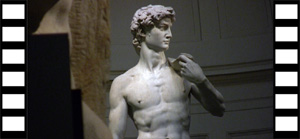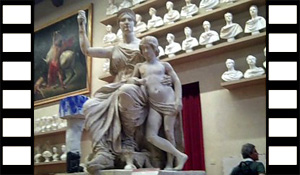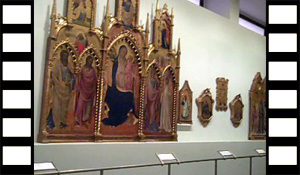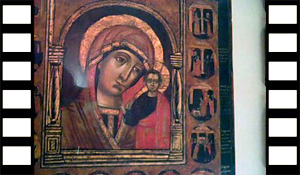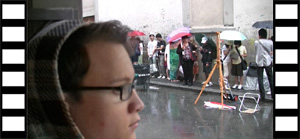Piazza della Santissima Annunziata (near Accademia)
During the tourist season, there is usually a long line to enter the Galleria dell'Accademia
(a good reason to procure a reservation online before visiting). While the people waiting
in line at a museum like the Uffizi might have an assortment of individual motivations to
visit, nearly all of those waiting to enter the Accademia are there for the same reason:
this is where Michelangelo's David lives. The Accademia was originally founded in
the late 18th Century as an art school (as one might infer from the name), with great works
of art brought in over time as subjects for the students to copy. The greatest to arrive
was David in 1873, which was being moved indoors from its original position in the
Piazza della Signoria to protect it from natural and human elements. As the copying of
older works subsequently faded from fashion, many of the other masterpieces found their way
to other museums (the Uffizi in particular), until the present, when a typical tourist's
summary of the Accademia might be "David … and some other stuff".
Anyway, here's David. This picture was taken with a certain amount of risk, as photography
is forbidden in the Gallery (there's a woman posted near David who yells in an
authoritarian voice at anyone venturing to point a camera). But the crowd is such that
it's difficult to soundly admonish all of the many practitioners of oafish behavior.

David, Michelangelo (1504)
Michelangelo completed David in 1504, when he was 29 years old, working with an
oddly-shaped piece of Carrara marble other artists had given up on 25 years earlier.
The statue was originally intended for placement on or near the Duomo, but instead ended
up next to the front door of the Palazzo Vecchio, displacing an earlier Donatello bronze.
Here are some more pictures of David, taken in 2000, when the rules were different.

David

David

David's Feet

David
As for the "other stuff", some of the more interesting pieces are also sculptures by
Michelangelo, but are unfinished. They are collectively known as "The Slaves", or sometimes
"The Prisoners", as one can see enough of the figures to easily imagine them struggling to
escape from the stone they're encased in. Most of them were intended for a grandiose tomb
Michelangelo had designed for Pope Julius II (more on him when we get to Rome), a
constantly-interrupted lifelong project which ended up being downsized considerably. The
St. Matthew statue was not part of this group, instead being intended for the Duomo.

David, Bearded Slave and St. Matthew

St. Matthew (unfinished), Michelangelo (1505-06)
The Bearded Slave
One large room, called the 19th Century Room, is filled with plaster statues, many created
by the early students.

Monument to Elisa Baciocchi, Bartolini

The 19th Century Room
There are also a lot of paintings in the Gallery, mostly pre-Renaissance. Again, some of
these pictures are from a visit in the year 2000.

Assorted Paintings

More Paintings

Nella and Painting

Crucifix with the Virgin and St. John, Daddi
At one point during our visit we could hear rain pounding down outside, and after
we exited, we were caught in another downpour. We ducked under an awning across from
the Accademia and didn't get too wet. We felt sorry for the unsheltered people waiting
in line to get in, but not too sorry to take pictures of them.
Waiting in the Rain
After the rain let up, we did some shopping at the San Lorenzo street market ("You, sir,
need a new hat!"), where Nella practiced her bargaining skills (lesson: just because a
vendor won't bargain with you, don't assume that others won't). Then we headed back to
the hotel to do some packing for our imminent departure, after which we headed over to
the nearby Piazza della Repubblica in search of dinner.







